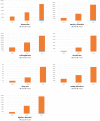A bibliometric analysis of international publications and citation trends of articles in mental health produced by Chinese institutions in mainland China (1990-2019)
- PMID: 34631113
- PMCID: PMC8482443
- DOI: 10.1017/gmh.2021.35
A bibliometric analysis of international publications and citation trends of articles in mental health produced by Chinese institutions in mainland China (1990-2019)
Abstract
Background: The recognition of the importance of mental health as a health-target to be pursued at a global level has received additional theoretical legitimacy through its inclusion in the United Nations (UN) 2030 Agenda for Sustainable development. The theoretical axiom - mental health as a development priority - is today expected to drive the focus of research efforts and orient the future policies and funds expenditures, at global and local level. According to these premises, it becomes central to track the international trajectories of mental health research and how the different countries are progressively defining their role in the global mental health effort. In this paper we have focused on China. In light of heavy burden of mental and substance use disorders affecting this country, and considering the impact of this burden at a global level, a basic research was conducted with the main aim of offering a preliminary view on the Chinese scientific activity within the context of global mental health research. This study is not intended to assess the quality of Chinese research, but merely to retrieve and measure a specific output of this research: the articles in mental-health produced by Chinese institutions based in mainland China, published in international journals. Although the publication of articles in internationally indexed journals in not exhaustive of China's scientific activity in global mental health, it is nevertheless informative of the production of new knowledge, it allows an assessment of the impact of this knowledge at the global scientific community level and it could partially reflect the Chinese capacity to benefit from research conducted globally.
Objective: In consideration of the very limited number of studies assessing the collective evidence of Chinese research in mental health, we developed our analysis with the purpose of providing a preliminary picture of the Chinese contribution, in terms of scientific publications, in this field of knowledge. Our research performs a bibliometric analysis on the articles in mental-health produced by Chinese institutions based in mainland China and published in English-language SCI-E and SSCI journals from 1990 to 2019, providing a measure of the impact of this research at the global scientific community level.
Methods: We performed a search on the Web of Science (WoS) using seven mental and substance use disorders according to their global prevalence, as per estimates of the Global Burden of Disease 2019. A dataset including the overall number of publications for seven diseases was created and exported in InCites. The dataset was analysed on the basis of 11 research areas (WoS categories) to which mental health topic is associated in SCI-E and SSCI journals in WoS. We further extracted publications that originated in mainland China. The citational trends over time are calculated with nonparametric test for trends across ordered groups. An evaluation of the impact of the Chinese scientific production is provided by the number of citations received at the global scientific community level, both as average and percentile.
Results: From 1990 to 2020 the overall Chinese scientific production in mental health has been generally increasing, reaching the highest growth in the last decade. A statistically significant increase (p < 0.001) is reported for articles produced by Chinese institutions in mainland China regarding 'depression*', 'bipolar disorders*' and 'schizophrenia*'. Published Chinese research is mostly included in SCI-E journals. There is a substantial overlap regarding the average number of citations for articles in mental-health produced by Chinese institutions and the rest of the world. Despite the increasing trend, the percentage of articles in mental health produced by Chinese institutions in mainland China on the overall scientific production worldwide is below 10%.
Conclusion: Notwithstanding a substantial increase in the last decade, the volume of Chinese publications appears to be very limited, thus resulting in a relatively low impact at a global level. These results are affecting the potential contribution of Chinese research in the global mental health effort.
Keywords: Bibliometric analysis; China; global mental health; mental health research.
© The Author(s) 2021.
Conflict of interest statement
None.
Figures







Similar articles
-
Assessing the evolution of scientific publications in orthopedics journals from mainland China, Hong Kong, and Taiwan: a 12-year survey of the literature.J Orthop Surg Res. 2016 Jun 17;11(1):69. doi: 10.1186/s13018-016-0404-z. J Orthop Surg Res. 2016. PMID: 27317092 Free PMC article. Review.
-
China's Contribution to Anesthesiology Research: A 10-Year Survey of the Literature.Anesth Analg. 2016 May;122(5):1640-5. doi: 10.1213/ANE.0000000000001225. Anesth Analg. 2016. PMID: 27003916 Review.
-
Publication Trends for Alzheimer's Disease Worldwide and in China: A 30-Year Bibliometric Analysis.Front Hum Neurosci. 2019 Aug 9;13:259. doi: 10.3389/fnhum.2019.00259. eCollection 2019. Front Hum Neurosci. 2019. PMID: 31447661 Free PMC article.
-
Scientific publications in anesthesiology journals from mainland China, Taiwan, and Hong Kong: a 10-year survey of the literature.Anesth Analg. 2010 Mar 1;110(3):918-21. doi: 10.1213/ANE.0b013e3181c793ee. Epub 2009 Dec 2. Anesth Analg. 2010. PMID: 19955511
-
The 50 Most-cited Articles in Orthopaedic Surgery From Mainland China.Clin Orthop Relat Res. 2015 Jul;473(7):2423-30. doi: 10.1007/s11999-015-4132-1. Epub 2015 Jan 15. Clin Orthop Relat Res. 2015. PMID: 25589444 Free PMC article.
References
-
- 中国医师协会精神科医师分会 (2019) 我国精神卫生工作的现状与展望, (Chinese Psychiatric Association 2019. Current status and prospects of mental health). Available at https://news.medlive.cn/psy/info-progress/show-156410_60.html (Accessed 17 December 2020).
-
- Charlson FJ, Baxter AJ, Cheng HG, Shidhaye R and Whiteford HA (2016) The burden of mental, neurological, and substance use disorders in China and India: a systematic analysis of community representative epidemiological studies. The Lancet 388, 376–389. - PubMed
-
- Cuzick J (1985) A Wilcoxon-type test for trend. Statistics in Medicine 4, 87–90. - PubMed
-
- Global Burden of Disease Study 2019 (2020). Institute for Health Metrics and Evaluation. Seattle, WA: IHME. Available athttp://www.healthdata.org/gbd/2019.
LinkOut - more resources
Full Text Sources
